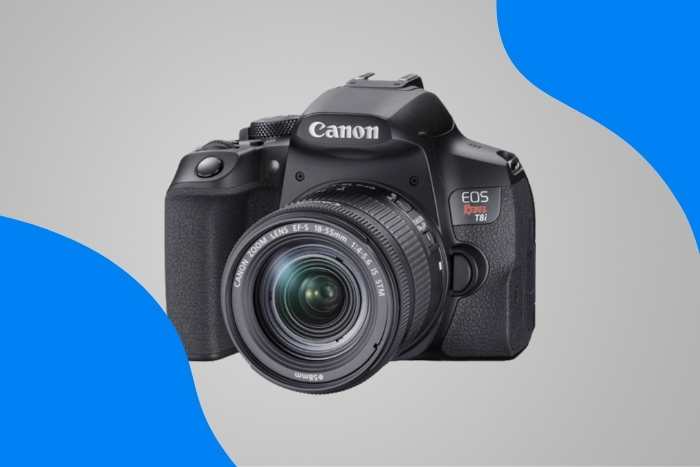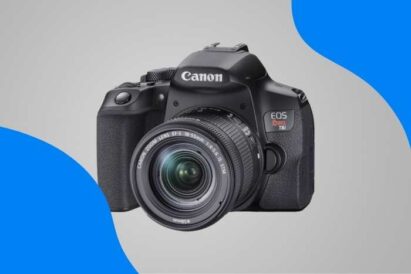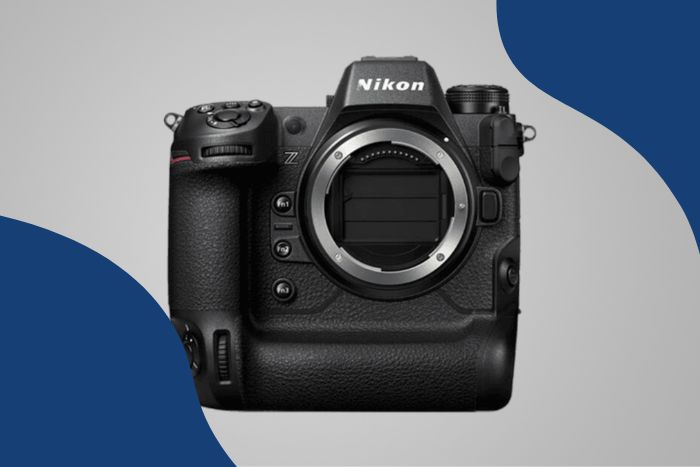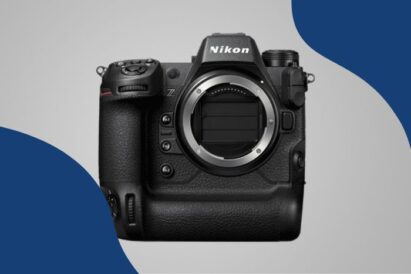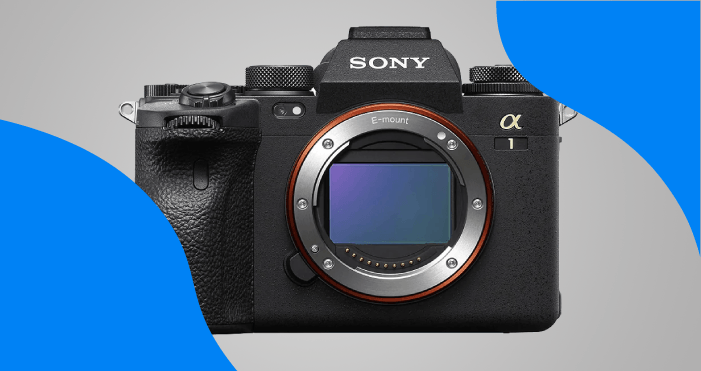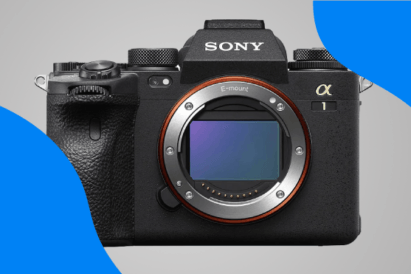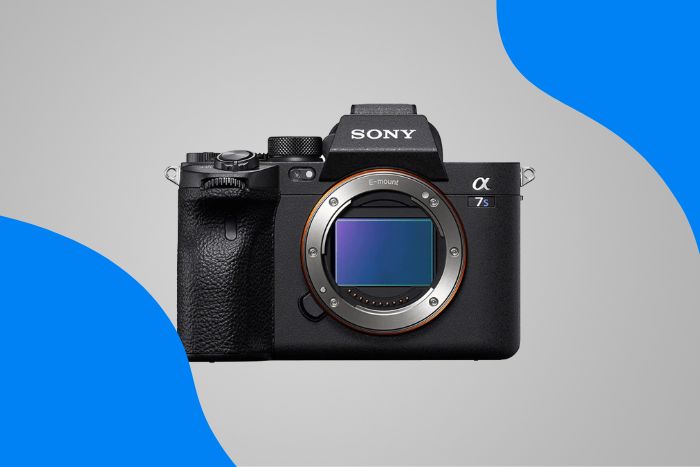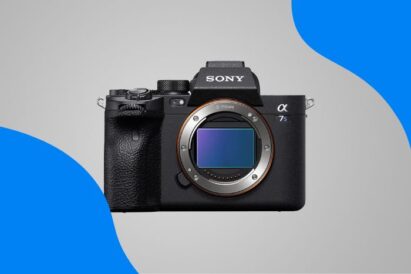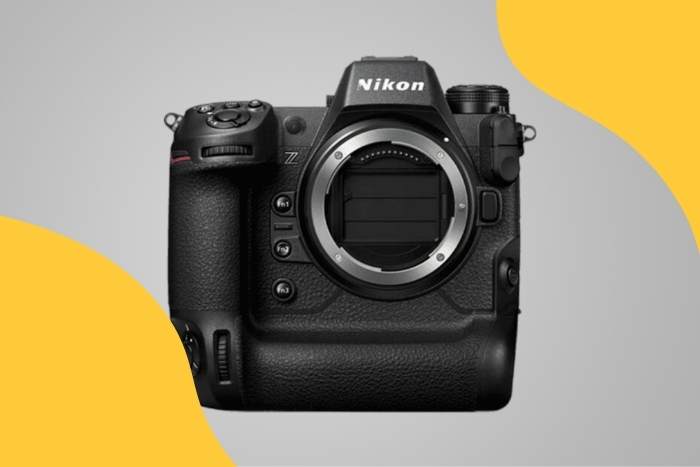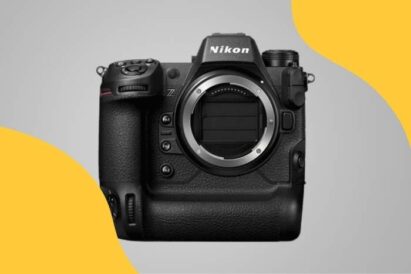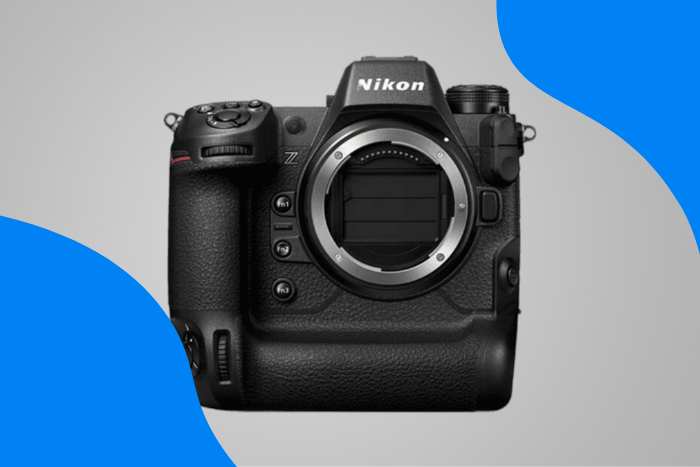DSLRs may be the bread and butter of Canon’s business. But they have also debuted tons of award-winning mirrorless cameras in recent years.
But with so many excellent choices available, how on earth are you supposed to determine which Canon camera for video is right for you?
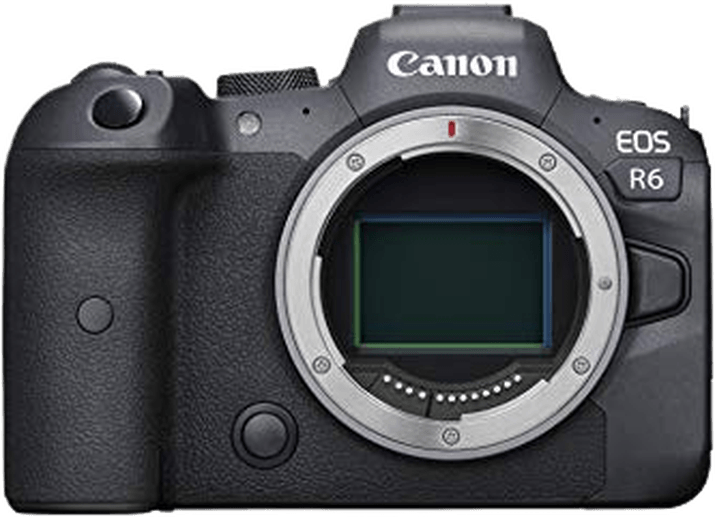
Canon EOS R6
Well, you have come to the right place!
After thorough research, we put together this exhaustive list. We break down all the best Canon mirrorless cameras for video. With digital cameras spanning every budget and skill level, your perfect camera is waiting below!
What is the Best Canon Mirrorless Camera for Video?
Our top choice out of all the Canon mirrorless cameras for video is the Canon EOS R6. Before we go through each camera in detail, here’s an overview of our top choices:

- Relatively affordable
- Excellent in-body image stabilization
- Compact and ergonomic design
- Fantastic expandable ISO range
- Rapid burst speeds
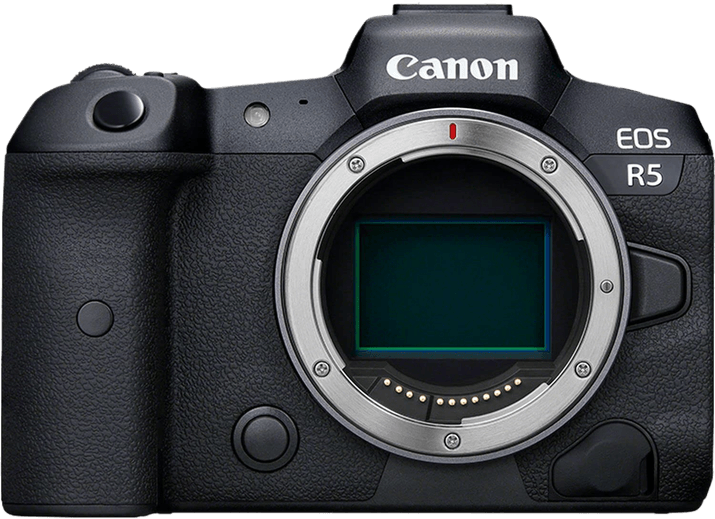
- Large 45 MP sensor
- High frame rate of 20 fps
- In-Body Image Stabilization (IBIS)
- Body, face, eye, and animal tracking
- 8K/30p Ultra HD video
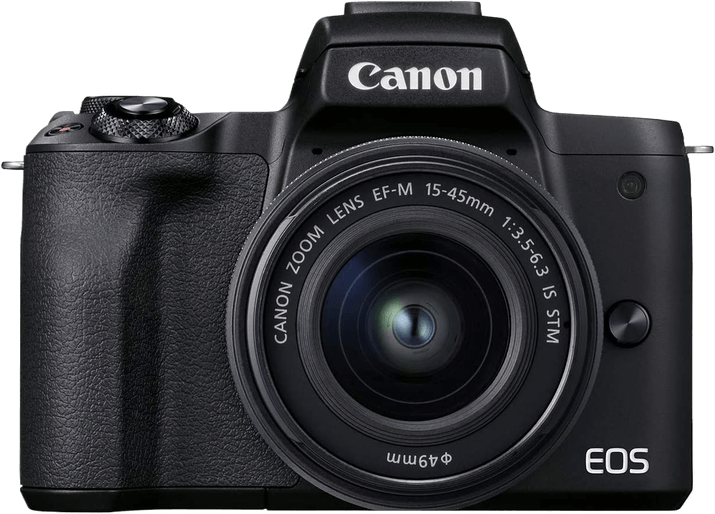
- Strong sensor resolution
- 4K and Full HD video options
- Time-lapse recording
- External mic port
- Webcam functionality
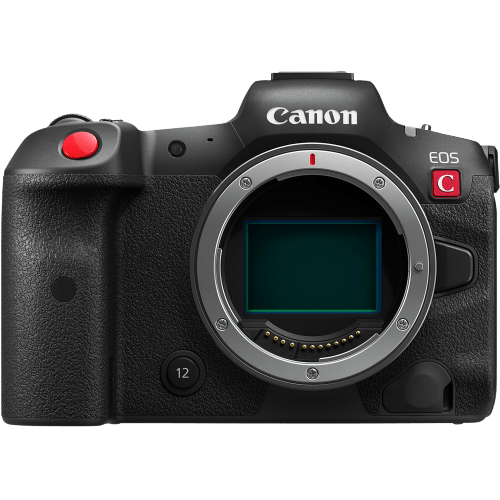
- The photo/video switch allows you to easily switch between shooting modes
- 5-axis In-camera image stabilization
- Compact and lightweight
- Unlimited video recording due to built-in fan preventing overheating
- Reduced video sizes with Cinema RAW Light modes
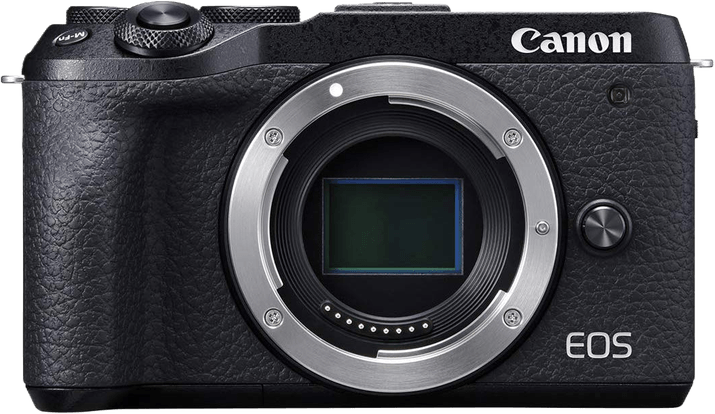
- Powerful 32.5 MP APS-C sensor
- Rapid 30 fps burst mode
- Uncropped 4K video with full AF
- Compact and lightweight body
- Accurate AF with face and eye detection
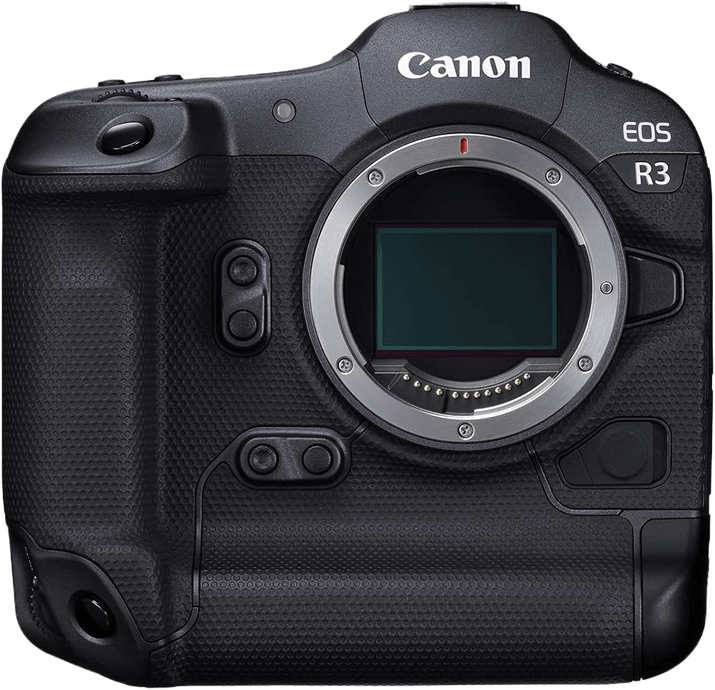
- A high frame rate of 30 fps
- Less noise with BSI stacked sensor
- 8 stops of image stabilization
- 6K / 60p RAW video
- 620-shot battery life
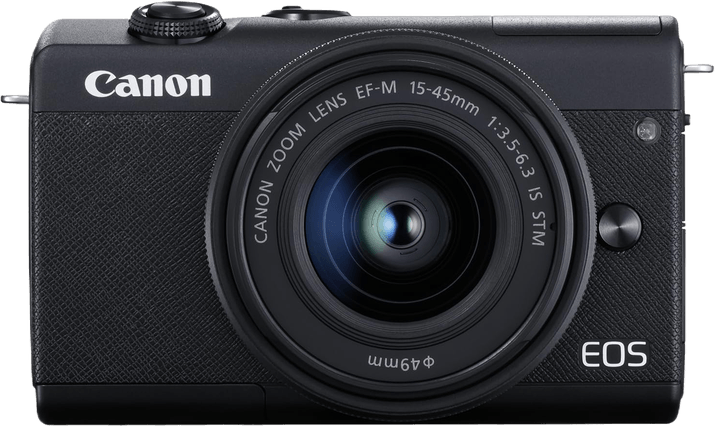
- Compact and lightweight body
- Smooth 4K video recording
- Vari-angle touchscreen
- Fast and reliable autofocus
- Wi-Fi and Bluetooth for easy sharing
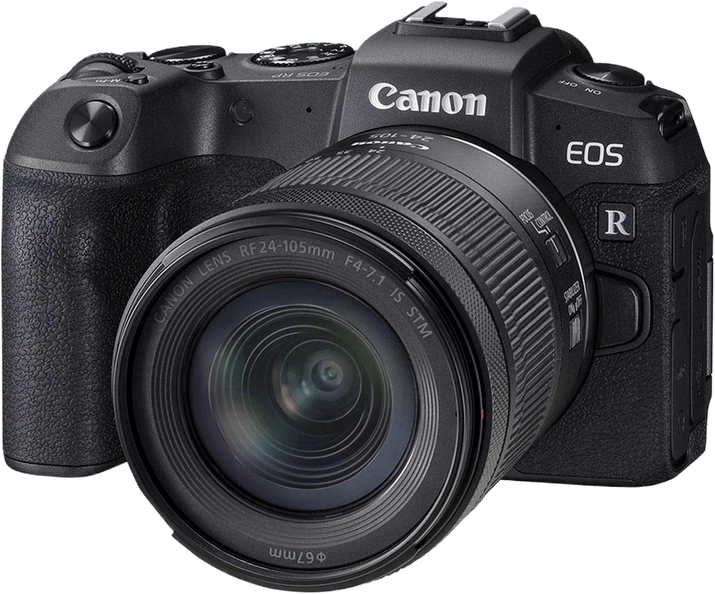
- Affordable full-frame mirrorless
- Lightweight and easy to handle
- Macro stacking and time-lapse
- Convenient Wi-Fi and Bluetooth
- Nice 4K video performance
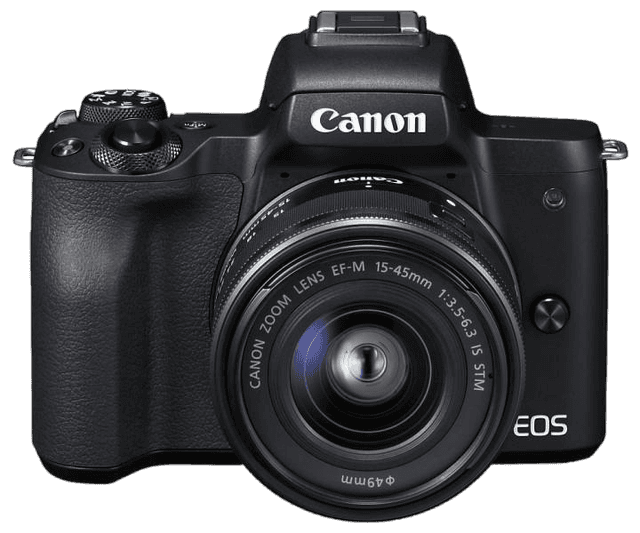
- Strong image resolution
- 4K and Full HD video options
- Dual Pixel AF system for stills
- Wi-Fi, NFC, and Bluetooth connectivity
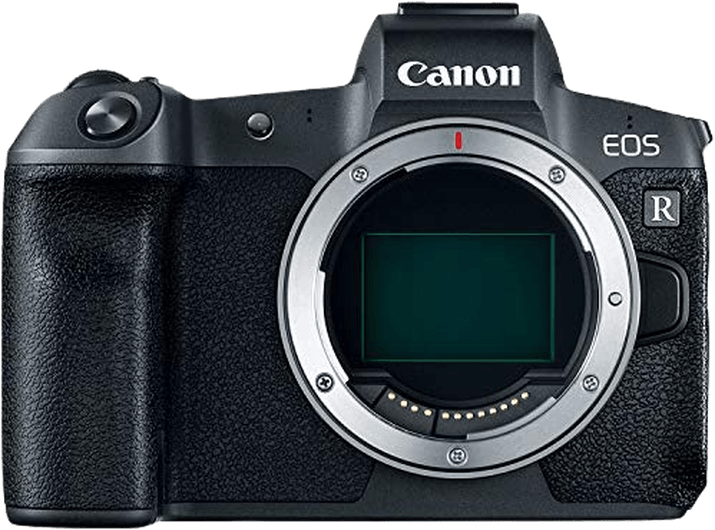
- Excellent autofocus system
- Excellent ISO range
- Ergonomic camera body
- Responsive and articulating touchscreen
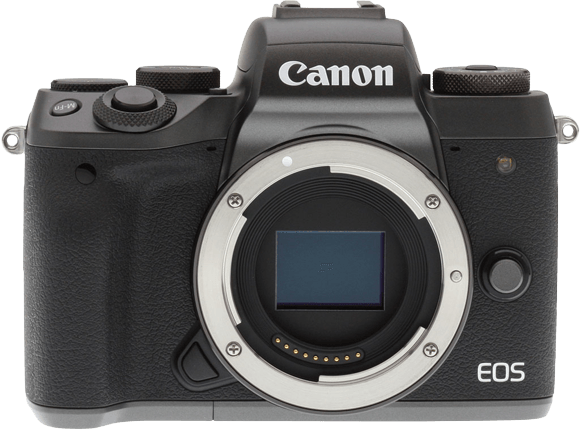
- Competitive image quality
- Good low-light performance
- Face detection AF
- Digital video stabilization
- Wi-Fi, Bluetooth, and NFC connectivity
11 Best Canon Mirrorless Cameras for Video in Detail
Here’s our complete list of Canon’s 11 best mirrorless cameras for video out there today. You’ll discover where each camera shines, where they have room for improvement, and who benefits most from shooting video with them.
1. Canon EOS R6

| Camera Type |
Camera Type
|
| Megapixels |
Megapixels
20.1 MP |
| Sensor Format |
Sensor Format
|
| Sensor Size |
Sensor Size
23.9 x 35.9 mm
|
| Frame Rate |
Frame Rate
20 fps |
| Autofocus Points |
Autofocus Points
1,053 |
- Relatively affordable
- Excellent in-body image stabilization
- Compact and ergonomic design
- Fantastic expandable ISO range
- Rapid burst speeds
- Low megapixel count compared to closest competitors
- Interface is challenging to navigate
- EVF drains the battery
- Camera heats up shooting 4K / 60 fps
The Canon EOS R6 is a semi-professional full-frame mirrorless camera that first hit stores in July 2020. It features a 20.1 megapixel CMOS sensor and a powerful Digic X image processor. The pair works together to deliver super sharp photos and videos. Additionally, they make the EOS R6 one of the fastest working mirrorless cameras ever.
The first thing that jumps off the page with this camera is that it records 4K video at three different frame rates. This allows you to create footage with a cinematic feel (24p), a natural look (30p), or reduced motion blur for playing back in slow-motion (60p). And filming at 1080p/120p Full HD, you can record slow-motion movies in-camera.
Furthermore, its best-in-class built-in image stabilization technology adds 6.5 stops of exposure. When paired with a stabilized lens, it has 8 stops of exposure. This makes it one of the best Canon mirrorless cameras for video during low-light and handheld shooting.
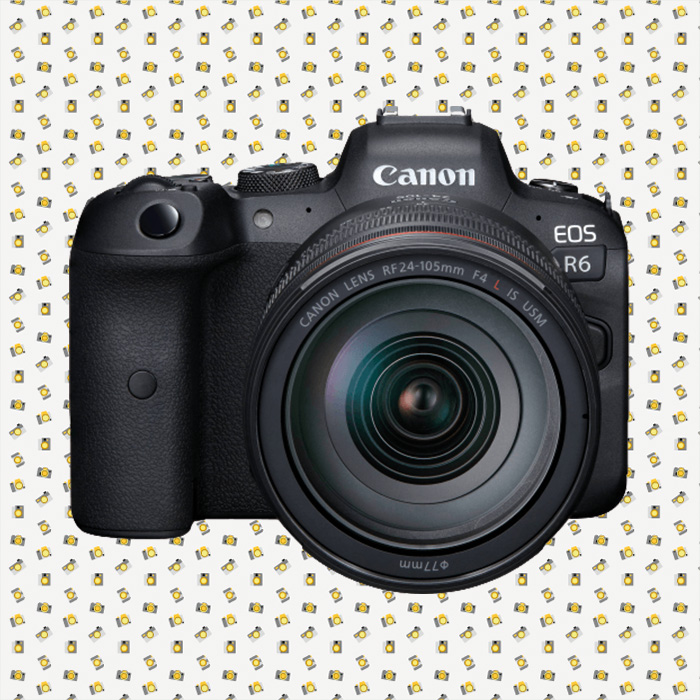
Two more features worth mentioning are the Dual Pixel AF II autofocus system and its dual SD card slots. Its 10-bit internal video recording takes up large quantities of space. But having two memory card slots allows you to record uninterrupted for longer.
There’s no other Canon camera in its price range that offers the same video features as the Canon R6. Whether you are a newbie looking for a camera to learn on, or a professional looking for a reliable backup, I promise this camera won’t disappoint you!
2. Canon EOS R5

| Camera Type |
Camera Type
|
| Megapixels |
Megapixels
45 MP |
| Sensor Format |
Sensor Format
|
| Sensor Size |
Sensor Size
23.9 x 35.9 mm
|
| Frame Rate |
Frame Rate
20 fps |
| Autofocus Points |
Autofocus Points
1,053 |
- Large 45 MP sensor
- High frame rate of 20 fps
- In-Body Image Stabilization (IBIS)
- Body, face, eye, and animal tracking
- 8K/30p Ultra HD video
- Expensive
- Complicated autofocus setup
- Noise reduction applied to RAW files
- Hard to customize
- Overheats shooting video
The Canon EOS R5 is the big brother to the EOS R6 and Canon’s flagship RF lens mount mirrorless camera. It boasts a high-resolution 45-megapixel full-frame CMOS sensor and an updated Digic X image processor. The new image processor, in particular, makes the camera faster and is what allows the camera to record high-resolution video.
It has mind-blowing 8K video capabilities, but a hefty price tag accompanies them. Yet, the value it provides hybrid photographers who shoot both videos and photos is unmatched.
The 8K footage is incredibly smooth, with even the tiniest details coming out sharp. On top of shooting 8K at 24p or 30p, the EOS R5 records 4K videos at speeds up to 120 fps (frames per second).
One group of people, in particular, who love this camera is wedding photographers. The Dual Pixel AF system covers 100% of the image sensor and quickly locates and tracks subjects. And you can capture every moment thanks to the 20 fps max continuous shooting speed.
3. Canon EOS M50 Mark II

| Camera Type |
Camera Type
|
| Megapixels |
Megapixels
24 MP |
| Sensor Format |
Sensor Format
|
| Sensor Size |
Sensor Size
14.9 x 22.3 mm
|
| Frame Rate |
Frame Rate
10 fps |
| Autofocus Points |
Autofocus Points
143 |
- Strong sensor resolution
- 4K and Full HD video options
- Time-lapse recording
- External mic port
- Webcam functionality
- 4K video is cropped
- No environmental sealing
- No sensor-shift image stabilization
- Disappointing battery life
For YouTubers, one of the most sought-after mirrorless cameras is the Canon EOS M50 Mark II. It’s the successor of the popular Canon EOS M50 and has a 24.1-megapixel APS-C sensor. Canon released it in February 2021.
While it has solid photography specs, its target audience is video content creators. It features 4K and 1080p Full HD video resolutions, with 4K movies recorded at 24 fps. Filming at 24 fps gives footage a smooth and cinematic look and is the go-to frame rate in Hollywood.
Unfortunately, one detail to note is that it applies a 1.55x crop factor during 4K shooting. But since many YouTubers prefer 1080p, it’s not a huge issue.
Another cool feature is that the Canon M50 Mark II can live stream to YouTube when connected to Wi-Fi. And the camera now offers a new Vertical Video mode aimed at Instagramers and TikTokers. This is crucial for people posting to those platforms, as it is their preferred aspect ratio and fills the entire screen.
4. Canon EOS R5 C

| Camera Type |
Camera Type
|
| Megapixels |
Megapixels
45 MP |
| Sensor Format |
Sensor Format
|
| Sensor Size |
Sensor Size
24 x 36 mm
|
| Frame Rate |
Frame Rate
20 fps |
| Autofocus Points |
Autofocus Points
1,053 |
- The photo/video switch allows you to easily switch between shooting modes
- 5-axis In-camera image stabilization
- Compact and lightweight
- Unlimited video recording due to built-in fan preventing overheating
- Reduced video sizes with Cinema RAW Light modes
- Expensive
- Limited native lens compatibility
- Continuous AF only covers 80% of the image sensor in video mode
- Bigger than the original EOS R5
- Must use an external battery source for the fastest shooting speeds
The Canon EOS R5 C was unveiled in January 2022 and is a spin-off of the Canon EOS R5. It’s an advanced video camera that pairs a 45-megapixel full-frame CMOS sensor with Canon’s fastest-ever Digic X image processor.
It combines all the best traits of the original camera with powerful new video capabilities to form a dream mirrorless camera for video. Like the EOS R5, this camera has 8K, 6K, and 4K video resolutions.
Moreover, the two cameras share the same in-camera image stabilization and Dual Pixel II autofocus systems. They make the R5 C ideal for low-light shooting and shooting handheld.
One new feature is a built-in cooling system. It gets rid of video recording limits and eliminates overheating issues. Also, it has a unique “video-photo” power switch. This simple toggle speeds up workflows by providing two operating systems and menus.
Finally, it boasts high-end video features such as Cinema RAW Light, timecodes, and waveform monitors. These are typically only present in high-end Canon cinema cameras like the Sony Venice 2.
5. Canon EOS M6 Mark II

| Camera Type |
Camera Type
|
| Megapixels |
Megapixels
33 MP |
| Sensor Format |
Sensor Format
|
| Sensor Size |
Sensor Size
14.9 x 22.3 mm
|
| Frame Rate |
Frame Rate
14 fps |
| Autofocus Points |
Autofocus Points
143 |
- Powerful 32.5 MP APS-C sensor
- Rapid 30 fps burst mode
- Uncropped 4K video with full AF
- Compact and lightweight body
- Accurate AF with face and eye detection
- No in-body image stabilization
- Limited screen articulation
- No built-in viewfinder
- Limited native lens selection
The Canon EOS M6 Mark II is an entry-level enthusiast camera that hit shelves in September 2019. It’s built around the Canon EF-M lens mount system and has a 32.5-megapixel APS-C CMOS sensor. It replaces the Canon EOS M6 as the premium vlogging camera in Canon’s EOS M lineup of crop sensor mirrorless cameras.
Measuring 120 x 70 x 49 mm and weighing only 408 grams, it’s one of the world’s most portable mirrorless cameras. When paired with compact lenses, it even fits in your pocket. This makes it a terrific choice for on-the-go shooters like street photographers and travel vloggers.
The EOS M6 Mark II captures 4K high-quality video at 30 fps and 1080p Full HD video clips at 120 fps. The latter is ideal for slow-motion playback.
Additionally, an incredible new 4K time-lapse mode builds smooth stop-motion movies in-camera. More notable video features include a removable electronic viewfinder (EVF), a flip-up touchscreen rear LCD screen for selfies, and excellent ergonomics.
6. Canon EOS R3

| Camera Type |
Camera Type
|
| Megapixels |
Megapixels
24 MP |
| Sensor Format |
Sensor Format
|
| Sensor Size |
Sensor Size
24 x 36 mm
|
| Frame Rate |
Frame Rate
30 fps |
| Autofocus Points |
Autofocus Points
1,053 |
- A high frame rate of 30 fps
- Less noise with BSI stacked sensor
- 8 stops of image stabilization
- 6K / 60p RAW video
- 620-shot battery life
- Relatively expensive
- Low-resolution for some photographers
- No 8K video
- Slowed frame rate with an SD card or low battery
Professionals will be blown away by the photo and video capabilities of the Canon EOS R3. It first went on sale in November 2021 and has received nonstop rave reviews since day one.
A 24.1-megapixel full-frame sensor and a speedy Digic X image processor are at its heart. The all-new image processor makes the camera lightning-fast and good for professionals.
It has stunning 6K video capabilities and shoots DCI (Digital Cinema Initiative) and UHD (Ultra HD) 4K. 6K video has a maximum frame rate of 60p, while 4K footage can go up to 120p.
And thanks to a variety of picture profiles, colors look bold and bright straight out of the camera. For you, this translates to more time behind the camera and less time in post-production.
Furthermore, the detail retention and dynamic range are arguably the best of any Canon camera, mirrorless or DSLR. Because of this, image quality in both photos and videos is excellent. Plus, one photography spec you can’t overlook is its industry-leading 30 fps max burst rate!
7. Canon EOS M200

| Camera Type |
Camera Type
|
| Megapixels |
Megapixels
24 MP |
| Sensor Format |
Sensor Format
|
| Sensor Size |
Sensor Size
14.9 x 22.3 mm
|
| Frame Rate |
Frame Rate
6.1 fps |
| Autofocus Points |
Autofocus Points
143 |
- Compact and lightweight body
- Smooth 4K video recording
- Vari-angle touchscreen
- Fast and reliable autofocus
- Wi-Fi and Bluetooth for easy sharing
- 4K video is cropped
- No audio jack for mic Input
- Lack of grip on body for large hands
- Slow RAW-file processing
- Limited shooting modes
The Canon EOS M200 is an ultralight mirrorless camera perfect for learning the basics of videography. Canon released it in September 2019 as the successor to the EOS M100. Moreover, it utilizes a 24.1 megapixel APS-C CMOS sensor and the fast Digic 8 image processor.
It has good but not great 4K capabilities, with the most significant downside being it applies a 1.7x crop factor during 4K/24p video recording. But the 1080p Full HD video quality is excellent and has the advantage of taking up less space on the SD card.
If you have your heart set on filming in 4K, I recommend investing in a wide-angle lens. The Canon EF-M 11-22mm is a great native lens. Or you can opt for an E-mount lens with the help of the EF-EOS M adapter.
Other fantastic features of the EOS M200 are the tilting LCD screen and responsive face-detection and eye-detection autofocus. They make the camera easy to use and perfect for newbies and kids.
Furthermore, it has built-in Wi-Fi to easily transfer photos and videos to your mobile device to share them with others or on social media.
8. Canon EOS RP

| Camera Type |
Camera Type
|
| Megapixels |
Megapixels
26 MP |
| Sensor Format |
Sensor Format
|
| Sensor Size |
Sensor Size
24 x 35.9 mm
|
| Frame Rate |
Frame Rate
5 fps |
| Autofocus Points |
Autofocus Points
4,779 |
- Affordable full-frame mirrorless
- Lightweight and easy to handle
- Macro stacking and time-lapse
- Convenient Wi-Fi and Bluetooth
- Nice 4K video performance
- 5 fps max burst is slow compared to competitors
- Relatively poor 250-shot battery life
- Doesn't function while charging
- 4K video is cropped 1.6x
As one of the lightest and most compact full-frame cameras, the Canon EOS RP is ideal for travel, outdoor, and adventure photographers. It’s an intermediate-level camera Canon launched in March 2019. It boasts a large 26.2-megapixel full-frame sensor paired with the advanced Digic 8 image-processing engine.
While it’s unbelievably tiny for a full-frame camera, Canon still managed to find a way to include two accessible exposure dials on the top of the device. Moreover, many of the controls and buttons are customizable. These traits, along with a highly intuitive main menu system, make the handling and ergonomics of the EOS RP off the charts!
Both 4K and 1080p movies have excellent edge-to-edge sharpness when using the EOS RP as a video camera. In addition, thanks to the microphone and headphone ports, it captures high-quality audio. And for weaknesses? Sadly, it applies a crop factor during 4K capture, and rolling shutter issues appear more often than we would like.
9. Canon EOS M50

| Camera Type |
Camera Type
|
| Megapixels |
Megapixels
24 MP |
| Sensor Format |
Sensor Format
|
| Sensor Size |
Sensor Size
14.9 x 22.3 mm
|
| Frame Rate |
Frame Rate
10 fps |
| Autofocus Points |
Autofocus Points
143 |
- Strong image resolution
- 4K and Full HD video options
- Dual Pixel AF system for stills
- Wi-Fi, NFC, and Bluetooth connectivity
- Cropped 4K video
- No Dual Pixel AF for 4K
- Poor battery life
- Limited native lens range
The Canon EOS M50 is the Canon EOS M50 Mark II predecessor. It first went on sale in March 2018.
After the release of the newer model, the M50 saw a notable drop in its price. This made it an excellent option for people on a budget. And despite its older age, it remains a capable and affordable camera for videographers and photographers alike.
Its 24.1-megapixel APS-C CMOS sensor and Digic 8 image processor work together to deliver sharp results consistently. The Dual Pixel AF system has 99 focus points, covers 80% of the image sensor, and has accurate face-detection and eye-detection capabilities. One critical detail to consider is that the Dual Pixel autofocus only works for photos and 1080p videos, not 4K.
Speaking of 4K, this digital camera records it at a frame rate of 24 fps. But it’s better suited for 1080p Full HD video recording. Besides a lack of Dual Pixel autofocus, 4K clips also have a 1.7x crop factor.
Lastly, the Canon EOS M50 can record 720p/120p slow-motion movies. And while the quality won’t win any awards, it’s a valuable feature to have.
10. Canon EOS R

| Camera Type |
Camera Type
|
| Megapixels |
Megapixels
30.3 MP |
| Sensor Format |
Sensor Format
|
| Sensor Size |
Sensor Size
24 x 36 mm
|
| Frame Rate |
Frame Rate
8 fps |
| Autofocus Points |
Autofocus Points
5,655 |
- Excellent autofocus system
- Excellent ISO range
- Ergonomic camera body
- Responsive and articulating touchscreen
- No in-body image stabilization
- 4K video is cropped
- No dual SD card slot
- Limited battery life compared to DSLR
The Canon EOS R debuted in October 2018 as the first camera in Canon’s all-new lineup of full-frame mirrorless cameras. Moreover, it was the first camera to use the new Canon RF lens mount system.
Some spectacular compatible video lenses are the Canon RF 24-70mm f/2.8, the Canon RF 1200mm f/8, and the Canon RF 5.2mm f/2.8 Dual Fisheye. While the number of native RF lenses is limited, you can unlock the entire Canon E mount lens catalog using the Canon EF-EOS R adapter.
It has a 30.3-megapixel full-frame sensor and a maximum 4K video resolution of 3840 x 2160 pixels. Plus, it can record 10-bit Canon log files externally and 8-bit Canon log files internally. This leads to movies that are not only detailed but have beautiful and bold color profiles as well.
While it is missing in-body image stabilization, nearly every Canon RF lens has it. So it’s by no means is it a deal-breaker. Additionally, the large sensor area and the comprehensive, dual native ISO range help the EOS R perform well during low-light shooting (indoors, sunrise, sunset, etc.).
11. Canon EOS M5

| Camera Type |
Camera Type
|
| Megapixels |
Megapixels
24.2 MP |
| Sensor Format |
Sensor Format
|
| Sensor Size |
Sensor Size
14.9 x 22.3 mm
|
| Frame Rate |
Frame Rate
9 fps |
| Autofocus Points |
Autofocus Points
49 |
- Competitive image quality
- Good low-light performance
- Face detection AF
- Digital video stabilization
- Wi-Fi, Bluetooth, and NFC connectivity
- Poor battery life
- Outdated AF system
- No environmental sealing
- No sensor-shift image stabilization
Last but not least, we have the Canon EOS M5. It’s Canon’s flagship entry-level mirrorless APS-C sensor camera and was released worldwide in November 2016. It uses a 24.2MP sensor and a Digic 7 image-processing engine to generate high-quality stills and videos for day-to-day shooters.
The biggest strength of this fun camera is how easy to use and straightforward it is. It has four control dials, a slew of customizable buttons, and a touchscreen interface. Whether you want to film the school play, capture your kid’s first time on a bike, or take photos around the house, the EOS M5 can do it with just the push of a button.
While 4K video is noticeably missing, the 1080p video quality is superb. Furthermore, movies are rarely blurry, courtesy of responsive autofocus and precise tracking.
More features worth highlighting include its high-resolution EVF and solid image stabilization technology. The large viewfinder helps to compose your scenes properly, and the stabilization reduces camera shake.
Our Verdict
Canon was late to the mirrorless camera game. But they have worked tirelessly to develop and release some phenomenal mirrorless cameras for video in the past few years. Regardless of which Canon camera you opt for, you’ll be thrilled with sharp-looking videos and impressive image quality.

Canon EOS R6
Our top recommendation for video recording is the Canon R6. But if you are primarily a photographer who also shoots videos, you should seriously consider either the Canon R5 or the Canon R.
Frequently Asked Question About Mirrorless Cameras
What is a Mirrorless Camera?
Mirrorless cameras are one of three primary camera systems. The other two are DSLR and compact (point-and-shoot) cameras.
They are interchangeable lens cameras whose name stems from the fact that they do not feature mirrors at their core. In place of the mirrors used by DSLRs, mirrorless cameras capture images from digital imaging sensors.
Additionally, they use electronic viewfinders instead of optical viewfinders. They display real-time “copies” of what the sensor sees (how your photos and videos will look).
Mirrorless cameras are a relatively new technology and the future of consumer cameras. While there are many reasons for their popularity, one of the main ones is their light and compact bodies.
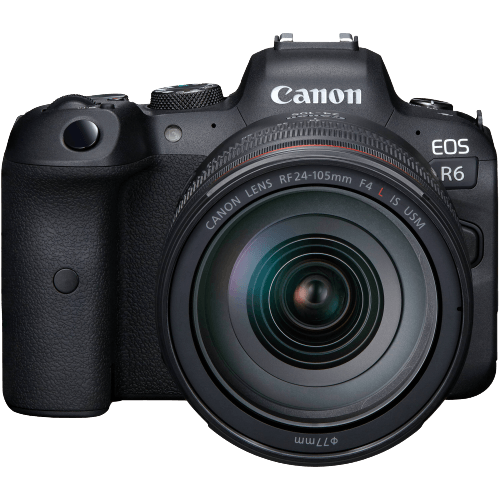
Is a Mirrorless Camera Better for Video?
There’s no easy answer to this question. I agree that mirrorless cameras deliver better results. But, it ultimately boils down to what camera you are shooting with and how you use that camera.
Everyone is obsessed with resolution these days (4K, 6K, 8K!). But, unless you are a professional filmmaker or videographer, it’s far from the most important video element. Not even the best mirrorless video camera will make your work stand out if you don’t know the basics of shooting video (frame rates, rules of composition, lighting, etc.).
Once you have mastered the basics, both mirrorless and DSLR cameras have advantages. For example, mirrorless systems tend to operate faster. And they have higher max resolutions thanks to more advanced image processing engines. But DSLR shooters point to better battery life and a more extensive lineup of compatible lenses.
Which Mirrorless Camera is Best for Video Shooting?
There is no clear cut, one shoe fits all, best camera for video shooting. But depending on the type of videos you typically make, some work better than others. Let’s review what we learned above.
- What is the best mirrorless camera for professionals? Professional Videographers should use the Canon EOS R5 and Canon EOS R3.
- What is the best Canon mirrorless camera for filmmakers and documentarians? The Canon EOS R5 C.
- What is the best option for YouTubers and vloggers? They can’t get enough of the Canon EOS M50 Mark II and the Canon EOS M6 Mark II.
If you are open to other camera brands, here are some of the best mirrorless cameras for video:
If you are still undecided, try compare camera specs of different brands and models for inspiration. You can check out our Canon R7 vs R10, Canon R3 vs R5, Canon R3 vs Sony Z9, or Canon R5 vs Sony a7R IV side-by-side comparisons to start!
Which is the Best Canon Camera for Videography?
For me, the best mirrorless camera for videography is the Canon EOS R6. Its advanced video features and affordable price make it an excellent choice. It’s fantastic for everyone, from beginners to professionals!
If you prefer working with DSLRs, the Canon 5D Mark IV is the best Canon camera for professionals. Or the Canon Rebel EOS SL3 is a good option for beginners.
Lastly, if you want a compact camera, the Canon PowerShot G5 X Mark II is the best Canon camera for videography.
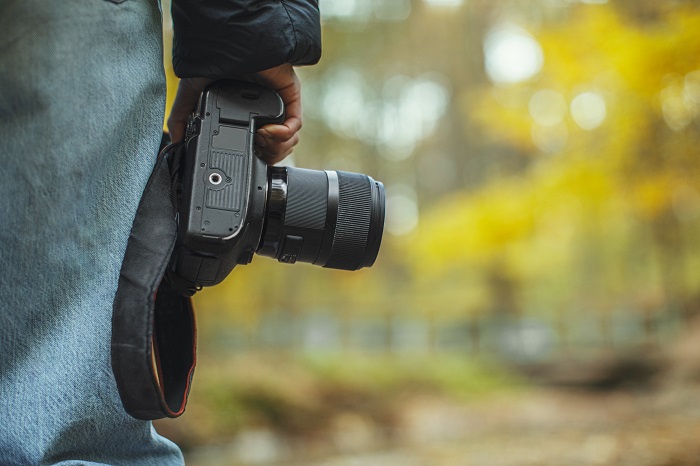
How Much Do Mirrorless Cameras Cost?
Mirrorless cameras have considerable variances in their prices. Entry-level cameras typically sell for anywhere between a few hundred and one thousand dollars. Mid-range intermediate cameras start around 1000 USD. And professional cameras can cost up to 5000 USD or more!
But keep in mind that’s just the camera body’s price. Since mirrorless cameras are interchangeable lens cameras, you will need to buy the lenses separately. So the best canon mirrorless camera for video may come at a steep price!


